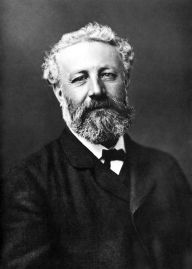Read an Excerpt
From Victoria Blake’s Introduction to Twenty Thousand Leagues Under the Sea
“There can never be another Jules Verne,” wrote Arthur C. Clarke, author of 2001: A Space Odyssey and a dedicated reader of Verne, “for he was born at a unique moment in time” (quoted in Teeters, p. 112). Verne was present at the birth of phosphorus matches, detachable collars, double cuffs, letterheads, and postage stamps. He saw the introduction of Loire river steamboats, railroads, trams, electricity, the telegraph, the telephone, and the phonograph. He was born into the age of Alexander Graham Bell, the Industrial Revolution, Karl Marx, Darwin, the colonization of Africa, and wars of independence around the world. In his lifetime the Suez Canal opened, the Hyatt brothers invented celluloid film, an electric generator was built in the Alps, the electromagnetic theory of light was proven, and scientists for the first time ordered elements by the number of their electrons, which paved the way for the modern periodic table.
Science was, for Verne, humankind’s greatest hope. At his best, he approached science with awe and naivete, making grandiose statements like, “When Science speaks, it behooves one to remain silent” (quoted in Evans, p. 48). Unlike many of his contemporaries, he did not consider the unknown aspects of the natural world beyond human understanding. “Let’s reason this out,” he wrote in The Mysterious Island (Evans, p. 52), displaying his faith in science as the great, organizing force. Verne was an optimist; he believed in the ability of the human mind to perceive and to eventually gain mastery over earth’s untamable mysteries through the discoveries of science.
His books accurately predicted many modern-day inventions, including the fax machine, the automobile, pollution, and even chain bookstores. In Twenty Thousand Leagues Under the Sea, he predicted batteries, searchlights, and the tazzers used by America’s police force. He foresaw the importance of electricity as a source of energy and suggested methods for air travel that later helped the first pilots get their feet off the ground. He anticipated the discovery of Darwin’s “missing link” between humans and apes. He even provided the technical details of the first manned trip to the moon. When the Apollo 8 mission returned from its voyage, one of the astronauts wrote Verne’s great-grandson a letter that praised the author’s predictive abilities in From the Earth to the Moon: “Our space vehicle was launched from Florida, like Barbican’s; it had the same weight and the same height, and it splashed down in the Pacific a mere two and a half miles from the point mentioned in the novel” (quoted in Teeters, p. 62).
In the more than 150 years since Verne’s first novel came off the press, seven generations of scientists and explorers have read his books. “It is Jules Verne who guides me,” wrote Antarctic explorer Richard E. Byrd (Teeters, p. 50).Jean Cocteau re-created Phileas Fogg’s round-the-world journey, completing his itinerary in eighty-two days. Walt Disney was a Verne reader. So was Robert Goddard, the American physicist known as the father of rocketry, who stated in 1919 that humans would one day put a man on the moon. Auguste Piccard, the Swiss physicist who in 1932 ascended 55,500 feet into the stratosphere in a balloon, and his son Jacques, who in 1960 descended to the deepest depression in the Pacific Ocean in a diving bell, read Verne. “Everybody read Jules Verne and felt that tremendous power to dream, which was part of his erudite and naïve genius,” wrote the author Ray Bradbury. “I consider myself as the illegitimate son of Jules Verne. We are very closely related” (quoted in Lynch, p. 113).
Though the accolades come in waves—and millions of readers worldwide have dreamed, traveled, and soared alongside Verne’s pen—it would be a mistake to close the book on Verne so quickly. Verne was more than a talented writer, a crafter of adventure plots, and a master of the scientific imagination. Like his noble and tragic Nemo, Verne cannot be defined so easily.
After his death, Verne willed a half-ton bronze safe to his son. The safe stayed in the family from generation to generation, until his great-grandson, Jean Verne, discovered it in a dusty corner of a storage shed. In all that time, the safe had never been opened. When Jean Verne opened it, he discovered one of Verne’s lost manuscripts. Paris in the Twentieth Century was published for the first time in 1994; it sold 100,000 copies and rose to the top of the French best-seller list.
True to style, the last of Verne’s published books accurately forecast twentieth-century life. But instead of Verne’s characteristic optimism—“All that’s within the limits of the possible must and will be accomplished” (quoted in Evans, p. 48). Paris au XXe siècle (Paris in the Twentieth Century) presents the future as tragic instead of hopeful, and science as the great destroyer instead of the great hope. In the book, Verne’s hero—this time a poet, not a scientist—wanders the streets of Paris looking for a publisher. But the citizens of Paris have forgotten the humanities and turned instead to the sterile comforts of life lived through science. Jobless and homeless, Verne’s hero walks the perfect streets of the city destitute and alone. He spends his last penny buying a flower for his beloved, but when he delivers it he finds the house empty, the family gone. The book concludes with the hero lost in a winter graveyard amid tombs of forgotten novelists before he collapses and dies on the frozen, snowy ground.



















